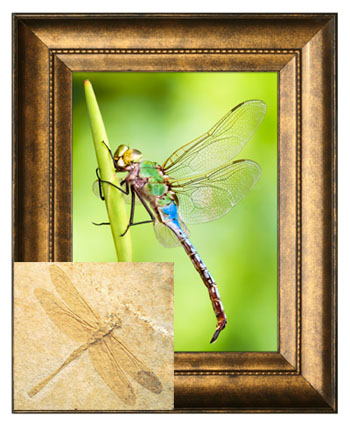 Living
Fossils: Portraits of the Fossilized Past by Mike
Matthews
Living
Fossils: Portraits of the Fossilized Past by Mike
MatthewsWhen a local fisherman hauled in a strange-looking blue fish off the South African coast, he had no clue about the significance of his find. It was a coelacanth. Until that day, the only known examples were in Devonian to Cretaceous rock layers. Secular scientists had been saying that this fish went extinct 70 million years ago.

Dragonfly photo © 2011 Bob Jensen
Fossil dragonfly photo: Creation Museum
Top photo: Green Darner (Anax junius). Bottom photo: Petalura fossil found in a Middle Jurassic rock layer located in Germany.
Since that year, 1938, many more “living fossils” have been discovered. Perhaps the most well-known recent find is the Wollemi pine tree, which a park officer stumbled upon in 1994 in a remote region of eastern Australia. “The discovery is the equivalent of finding a small dinosaur still alive on Earth,” gushed the director of the Royal Botanic Gardens.
Far from being an oddity, living fossils are found throughout the fossil layers. In fact, almost every “family” of living animal has an amazingly similar ancestor preserved deep in the fossil record (see detachable chart on p. 85). What does this mean?
Two alternatives have been suggested to explain the connection between fossils and modern life. Before the mid-1700s, fossils were commonly explained as remnants of the Flood just a few thousand years ago. When many scientists began to reject the Bible in the 1700s, however, they envisioned earth history as a succession of catastrophes over millions of years. They assumed that fossils represented “ancient life” very unlike today.

Wasp photo © 2011 Bob Jensen
Fossil wasp photo: Creation Museum
Top photo: Predatory wasp (Philanthus multimaculatus). Bottom photo: Wasp fossil (undetermined species) found in an Oligocene rock layer located in the United States.
Among the latter was Charles Darwin, who coined the term living fossil in his book On the Origin of Species (1859). He cites two examples of what “may almost be called living fossils”: the platypus (a mammal that had a duck-like bill and laid eggs like a reptile) and the lungfish (a fish that breathed with “lungs” like a land animal).
Darwin used the term living fossil differently than we see it used today. (Today “living fossil” typically describes a living organism that looks like a fossilized organism but has no close living relatives by evolutionary reckoning.) In Darwin’s day little was known about the fossils of platypuses and lungfish. In his view, a living fossil was an organism that looked similar to what he imagined evolutionary transitions should have looked like.
Since Darwin’s day, scientists have realized that the platypus and lungfish are not evolutionary transitions; they are just two bizarre-looking creatures with a mishmash of body traits. The surviving species look very similar to fossil platypuses and fossil lungfish, but they have no known family connection to other creatures.

Photo: Creation Museum
Top photo: Modern-day crab. Bottom photo: Harpactocarcinus punetulatus fossil found in an Eocene rock layer located in Italy.
If animals evolved from a common ancestor, we might expect a few forms to be so “successful” that they could persist unchanged for millions of years. But surely since environments are always changing, they would eventually go extinct. This means that we should find fewer and fewer fossils of “living fossils” as we delve deeper in the fossil record.
Yet we find fossils similar to living creatures throughout the fossil record!
A logical explanation is the Flood of Noah’s day. The Flood would have buried and preserved specimens from environments all over the world. After the waters receded, new environments would have arisen haphazardly; and only those creatures that were well-equipped for these new environments would survive, while others would quickly go extinct.
In this scenario, all creatures had the same amount of time to adapt, no matter where their ancestors appeared in the fossil record. So we would expect “living fossils” from every layer.
Some creatures, such as wasps, crabs, dragonflies, and crocodiles, obviously adapted and continued to thrive. Other animals, such as dinosaurs and trilobites, faced drastically different environments and did not do so well.
Romans 1:18–20 implies one reason behind this persistence of biological forms. The Creator says His attributes are “clearly seen” in the things He has made. Even in the biological communities that arose after the Flood, God made sure that Noah’s descendants—including us today—would still see His glory and wisdom in nature.
While dinosaurs no longer walk the earth (as far as we know), we can still observe living examples of animals and plants that shared the world with dinosaurs. In addition, God has given us enough resources to imagine what these magnificent creatures must have looked like before they passed from the scene.